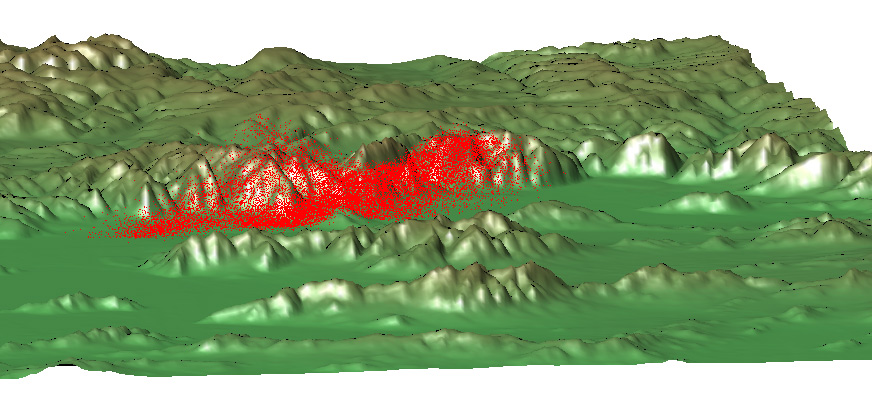NARAC's primary dispersion model, the Lagrangian Operational Dispersion Integrator (LODI), uses wind, turbulence, and other gridded meteorological fields generated by NARAC's ADAPT meteorological data assimilation model to predict 2-D and 3-D gridded concentrations of hazardous material released into the atmosphere. LODI outputs time series of instantaneous and time-integrated air concentrations and ground deposition.
LODI uses a stochastic (Monte Carlo) particle diffusion method to solve the 3-D advection-diffusion equation by calculating possible trajectories of fluid "particles" in a turbulent flow. These "particles" can represent radiological, chemical, or biological materials in gaseous, liquid, or solid form. Multiple hazardous material sources can be modeled in a single LODI run using point, line, area, sphere, or Gaussian-shaped source geometries, moving as well as static sources, and time-varying emission rates. Additional specialized source term algorithms describe the detailed time evolution of the source geometry when these cannot be adequately represented by basic geometric shapes, including:
- Thermal and/or momentum driven plume rise from a stack, vent, or fire
- Detonation of chemical high explosives
- Nuclear detonations resulting in distinct base surge, stem, and cap clouds
Other key LODI features include treatment of:
- Aerosol mass-size distributions, specified either as a log-normal distribution or as a table of distinct mass fractions and size ranges
- First-order decay of biological and chemical material
- Decay and production of mixtures of radioisotopes during atmospheric transport
- Dry deposition based on gravitational settling velocity and deposition resistance
- Precipitation scavenging based on aerosol size and spatially and temporally varying precipitation rates
- Weathering and resuspension
LODI outputs are post-processed to create NARAC map products showing air or ground contamination, dose, and health effects resulting from the hazardous material release. Model results can also be converted to specific levels of concern, such as EPA/DHS protective action guide levels for radiological releases, EPA/AIHA/DOE chemical exposure guideline levels for chemical releases, or biological agent lethal dose probabilities. (see Hazardous Material Property and Exposure Data)





